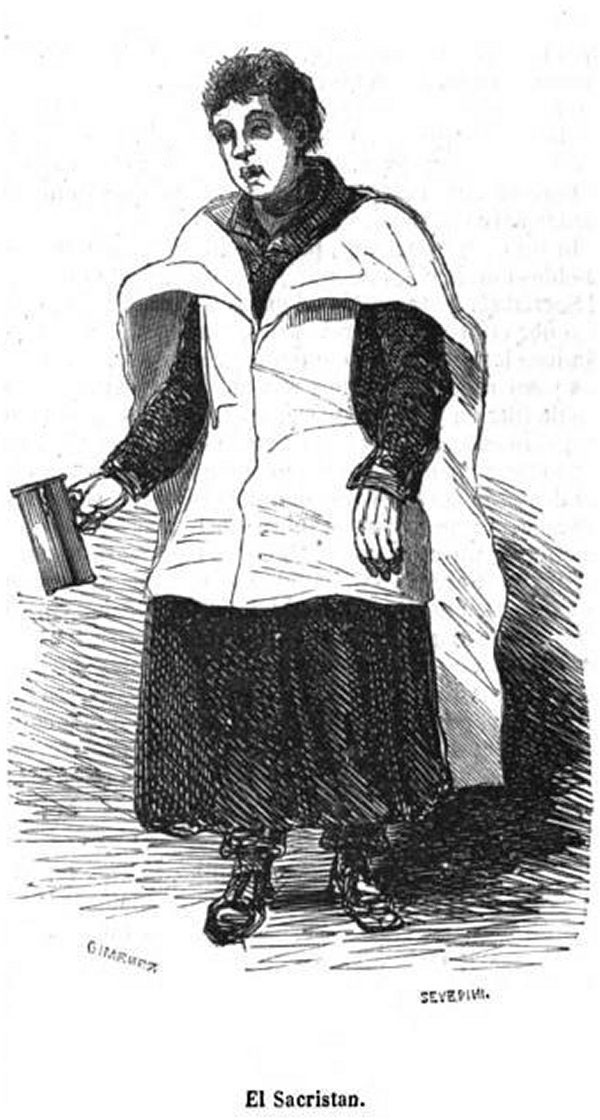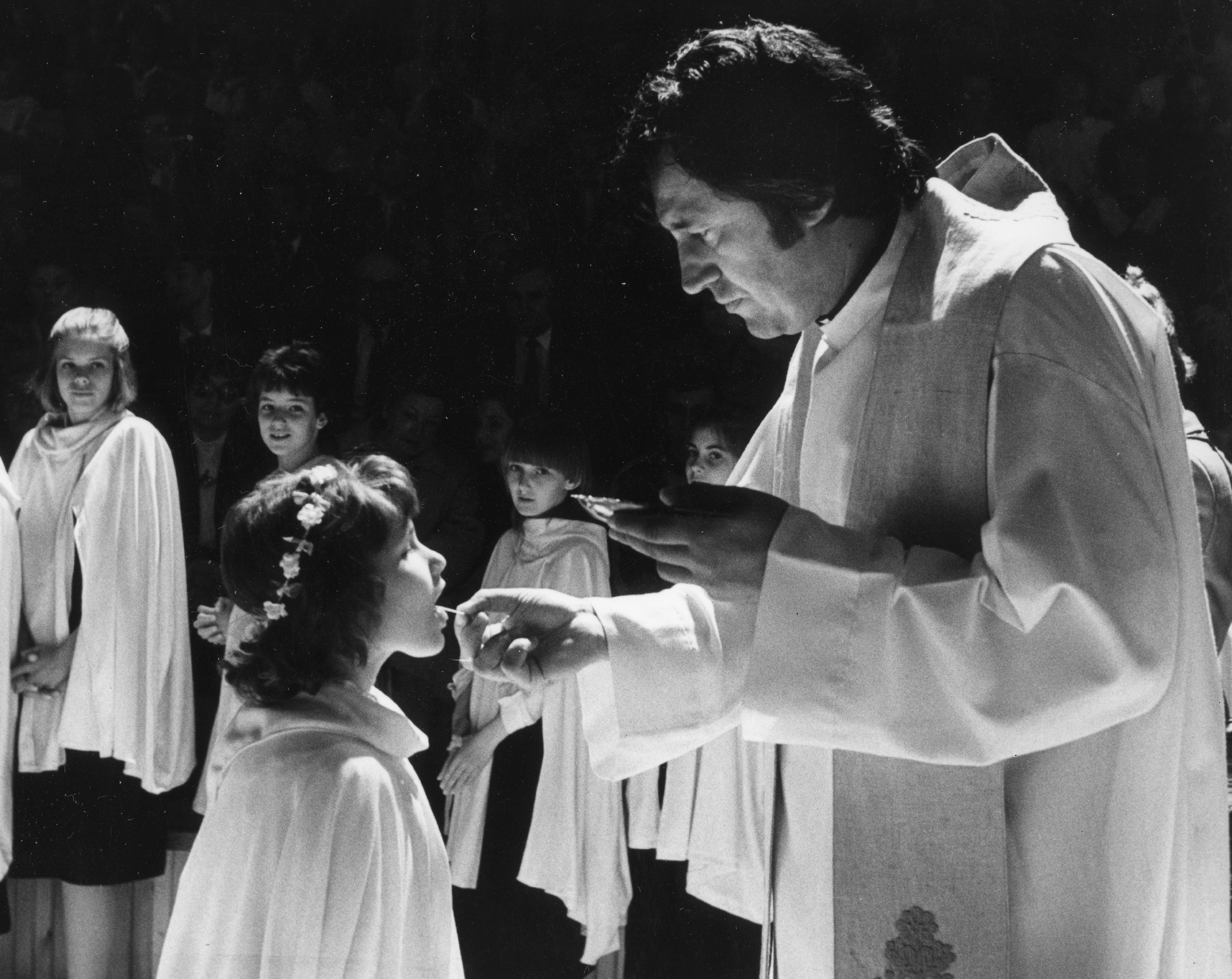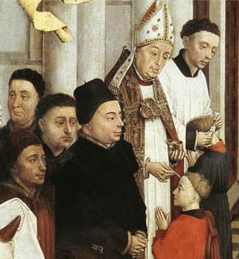|
Teodora Fracasso
Teodora Fracasso (17 January 1901 - 25 December 1927) - in religious Elia di San Clemente - was an Italian Roman Catholic professed religious from the Carmelites. Fracasso once had the name of "Agnes" during a stint in the Third Order of Saint Dominic. Fracasso's inclinations to become a nun stemmed from her childhood after having had a vision in 1911 in which Thérèse of Lisieux told her that she would become a nun; this realization came a decade later when she entered the convent in her native Bari where she remained for the remainder of her life. Her beatification cause was opened on 11 September 1980 and she became titled as a Servant of God when the cause commenced and this led to the confirmation of her heroic virtue which allowed for Pope John Paul II to name her as Venerable. Pope Benedict XVI later approved her beatification which Cardinal José Saraiva Martins presided over on 18 March 2006 on the pope's behalf in the Bari Cathedral. Life Teodora Fracasso was born on 1 ... [...More Info...] [...Related Items...] OR: [Wikipedia] [Google] [Baidu] |
Beatification
Beatification (from Latin ''beatus'', "blessed" and ''facere'', "to make”) is a recognition accorded by the Catholic Church of a deceased person's entrance into Heaven and capacity to intercede on behalf of individuals who pray in their name. ''Beati'' is the plural form, referring to those who have undergone the process of beatification; they possess the title of "Blessed" (abbreviation "Bl.") before their names and are often referred to in English as "a Blessed" or, plurally, "Blesseds". History Local bishops had the power of beatifying until 1634, when Pope Urban VIII, in the apostolic constitution ''Cœlestis Jerusalem'' of 6 July, reserved the power of beatifying to the Holy See. Since the reforms of 1983, as a rule, one miracle must be confirmed to have taken place through the intercession of the person to be beatified. Miracles are almost always unexplainable medical healings, and are scientifically investigated by commissions comprising physicians and theologia ... [...More Info...] [...Related Items...] OR: [Wikipedia] [Google] [Baidu] |
Heroic Virtue
Heroic virtue is a phrase coined by Augustine of Hippo to describe the virtue of early Christian martyrs and used by the Catholic Church. The Greek pagan term hero described a person with possibly superhuman abilities and great goodness, and "it connotes a degree of bravery, fame, and distinction which places a man high above his fellows".Catholic Encyclopedia of 1917 The term was later applied to other highly virtuous persons who do extraordinary good works. Heroic virtue is one of the requirements for beatification in the Catholic Church. The modern process for declaring heroic virtue is internal to the church and conducted by those in senior positions. Quoting the Catholic view from the article on Heroic Virtue by J. Wilhelm in the 1917 ''Catholic Encyclopedia'': Together with the four cardinal virtues the Christian saint must be endowed with the three theological virtues, especially with Divine charity, the virtue which informs all other virtues. As charity stands at ... [...More Info...] [...Related Items...] OR: [Wikipedia] [Google] [Baidu] |
Sacristan
A sacristan is an officer charged with care of the sacristy, the church, and their contents. In ancient times, many duties of the sacrist were performed by the doorkeepers ( ostiarii), and later by the treasurers and mansionarii. The Decretals of Gregory IX speak of the sacristan as if he had an honourable office attached to a certain benefice, and say that his duty was to care for the sacred vessels, vestments, lights, etc. Nowadays the sacristan is elected or appointed. The '' Cæremoniale Episcoporum'' prescribed that in cathedral and collegiate churches the sacristan should be a priest, and describes his duties in regard to the sacristy, the Blessed Eucharist, the baptismal font, the holy oils, the sacred relics, the decoration of the church for the different seasons and feasts, the preparation of what is necessary for the various ceremonies, the pregustation in pontifical Mass, the ringing of the church bells, the preservation of order in the church, and the distribution ... [...More Info...] [...Related Items...] OR: [Wikipedia] [Google] [Baidu] |
Society Of Jesus
, image = Ihs-logo.svg , image_size = 175px , caption = ChristogramOfficial seal of the Jesuits , abbreviation = SJ , nickname = Jesuits , formation = , founders = , founding_location = , type = Order of clerics regular of pontifical right (for men) , headquarters = Generalate:Borgo S. Spirito 4, 00195 Roma-Prati, Italy , coords = , region_served = Worldwide , num_members = 14,839 members (includes 10,721 priests) as of 2020 , leader_title = Motto , leader_name = la, Ad Majorem Dei GloriamEnglish: ''For the Greater Glory of God'' , leader_title2 = Superior General , leader_name2 = Fr. Arturo Sosa, SJ , leader_title3 = Patron saints , leader_name3 = , leader_title4 = Ministry , leader_name4 = Missionary, educational, literary works , main_organ = La Civiltà Cattoli ... [...More Info...] [...Related Items...] OR: [Wikipedia] [Google] [Baidu] |
Order Of Preachers
The Order of Preachers ( la, Ordo Praedicatorum) abbreviated OP, also known as the Dominicans, is a Catholic mendicant order of Pontifical Right for men founded in Toulouse, France, by the Spanish priest, saint and mystic Dominic of Caleruega. It was approved by Pope Honorius III via the papal bull ''Religiosam vitam'' on 22 December 1216. Members of the order, who are referred to as ''Dominicans'', generally carry the letters ''OP'' after their names, standing for ''Ordinis Praedicatorum'', meaning ''of the Order of Preachers''. Membership in the order includes friars, nuns, active sisters, and lay or secular Dominicans (formerly known as tertiaries). More recently there has been a growing number of associates of the religious sisters who are unrelated to the tertiaries. Founded to preach the Gospel and to oppose heresy, the teaching activity of the order and its scholastic organisation placed the Preachers in the forefront of the intellectual life of the Middle Age ... [...More Info...] [...Related Items...] OR: [Wikipedia] [Google] [Baidu] |
Spiritual Direction
Spiritual direction is the practice of being with people as they attempt to deepen their relationship with the divine, or to learn and grow in their personal spirituality. The person seeking direction shares stories of their encounters of the divine, or how they are cultivating a life attuned to spiritual things. The director listens and asks questions to assist the directee in his or her process of reflection and spiritual growth. Spiritual direction advocates claim that it develops a deeper awareness with the spiritual aspect of being human, and that it is neither psychotherapy nor counseling nor financial planning. Historians of philosophy like Ilsetraut and Pierre Hadot have argued that spiritual direction was already practiced and recommended by the main schools of philosophy, as well as by physicians like Galen, as part of spiritual practices in Ancient Greece and Rome. Roman Catholic forms While there is some degree of variability, there are primarily two forms of spi ... [...More Info...] [...Related Items...] OR: [Wikipedia] [Google] [Baidu] |
Thomas Aquinas
Thomas Aquinas, OP (; it, Tommaso d'Aquino, lit=Thomas of Aquino; 1225 – 7 March 1274) was an Italian Dominican friar and priest who was an influential philosopher, theologian and jurist in the tradition of scholasticism; he is known within the tradition as the , the , and the . The name ''Aquinas'' identifies his ancestral origins in the county of Aquino in present-day Lazio, Italy. Among other things, he was a prominent proponent of natural theology and the father of a school of thought (encompassing both theology and philosophy) known as Thomism. He argued that God is the source of both the light of natural reason and the light of faith. He has been described as "the most influential thinker of the medieval period" and "the greatest of the medieval philosopher-theologians". His influence on Western thought is considerable, and much of modern philosophy is derived from his ideas, particularly in the areas of ethics, natural law, metaphysics, and political theory. ... [...More Info...] [...Related Items...] OR: [Wikipedia] [Google] [Baidu] |
Imelda Lambertini
Imelda Lambertini (1322 – May 12, 1333) is the patroness of First Communicants. Biography Imelda Lambertini was born in 1322 in Bologna, the only child of Count Egano Lambertini and Castora Galuzzi. Her parents were devout Catholics and were known for their charity and generosity to the underprivileged of Bologna. On her fifth birthday, she requested to receive the Eucharist; however the custom at the time was that children did not receive their First Communion until age 14. At age nine, she went to live with the Dominican nuns at Val di pietra, near Bologna. On May 12, 1333, the day of the vigil of the Ascension, she knelt in prayer and the "Light of the Host" was reportedly witnessed above her head by the Sacristan, who then fetched the priest so he could see. After seeing this miracle, the priest felt compelled to admit her to receiving the Eucharist. Immediately after receiving it, Imelda went back to her seat, and decided to stay after Mass and pray. Later whe ... [...More Info...] [...Related Items...] OR: [Wikipedia] [Google] [Baidu] |
First Communion
First Communion is a ceremony in some Christian traditions during which a person of the church first receives the Eucharist. It is most common in many parts of the Latin Church tradition of the Catholic Church, Lutheran Church and Anglican Communion (other ecclesiastical provinces of these denominations administer a congregant's First Communion after they receive baptism and confirmation). In churches that celebrate a rite of First Communion separate from baptism or confirmation, it typically occurs between the ages of seven and thirteen, often acting as a rite of passage. In other denominations first communion ordinarily follows the reception of confirmation, which occurs at some point in adolescence or adulthood, while Eastern Orthodox and Oriental Orthodox Christians first receive the sacrament of Holy Communion in infancy, along with Holy Baptism and Chrismation. Characteristics Catholics believe this event to be very important, as the Eucharist occupies a central role in Cat ... [...More Info...] [...Related Items...] OR: [Wikipedia] [Google] [Baidu] |
Blessed Virgin Mary
Mary; arc, ܡܪܝܡ, translit=Mariam; ar, مريم, translit=Maryam; grc, Μαρία, translit=María; la, Maria; cop, Ⲙⲁⲣⲓⲁ, translit=Maria was a first-century Jewish woman of Nazareth, the wife of Joseph and the mother of Jesus. She is a central figure of Christianity, venerated under various titles such as virgin or queen, many of them mentioned in the Litany of Loreto. The Eastern and Oriental Orthodox, Church of the East, Catholic, Anglican, and Lutheran churches believe that Mary, as mother of Jesus, is the Mother of God. Other Protestant views on Mary vary, with some holding her to have considerably lesser status. The New Testament of the Bible provides the earliest documented references to Mary by name, mainly in the canonical Gospels. She is described as a young virgin who was chosen by God to conceive Jesus through the Holy Spirit. After giving birth to Jesus in Bethlehem, she raised him in the city of Nazareth in Galilee, and was in Jeru ... [...More Info...] [...Related Items...] OR: [Wikipedia] [Google] [Baidu] |
Confirmation (Catholic Church)
Confirmation, in the Catholic Church, is one of the seven sacraments. It is also one of the three sacraments of initiation into the Catholic Church, the other two being Baptism and Holy Communion. Description The ''Catechism of the Catholic Church'' states: It is evident from its celebration that the effect of the sacrament of Confirmation is the special outpouring of the Holy Spirit as once granted to the apostles on the day of Pentecost... Recall then that you have received the spiritual seal, the spirit of wisdom and understanding, the spirit of right judgment and courage, the spirit of knowledge and reverence, the spirit of holy fear in God's presence. Guard what you have received. God the Father has marked you with his sign; Christ the Lord has confirmed you and has placed his pledge, the Spirit, in your hearts. The ''Catechism of the Catholic Church'' sees the account in the Acts of the Apostles as a scriptural basis for Confirmation as a sacrament distinct from Baptism: ... [...More Info...] [...Related Items...] OR: [Wikipedia] [Google] [Baidu] |
Baptism
Baptism (from grc-x-koine, βάπτισμα, váptisma) is a form of ritual purification—a characteristic of many religions throughout time and geography. In Christianity, it is a Christian sacrament of initiation and adoption, almost invariably with the use of water. It may be performed by sprinkling or pouring water on the head, or by immersing in water either partially or completely, traditionally three times, once for each person of the Trinity. The synoptic gospels recount that John the Baptist baptised Jesus. Baptism is considered a sacrament in most churches, and as an ordinance in others. Baptism according to the Trinitarian formula, which is done in most mainstream Christian denominations, is seen as being a basis for Christian ecumenism, the concept of unity amongst Christians. Baptism is also called christening, although some reserve the word "christening" for the baptism of infants. In certain Christian denominations, such as the Lutheran Churches, baptism ... [...More Info...] [...Related Items...] OR: [Wikipedia] [Google] [Baidu] |







